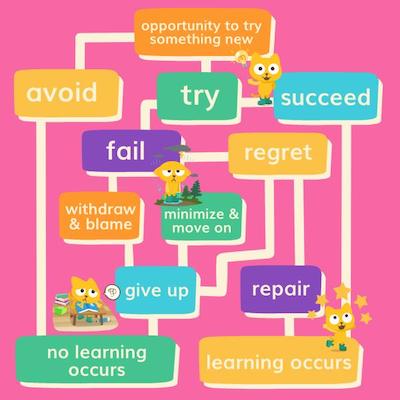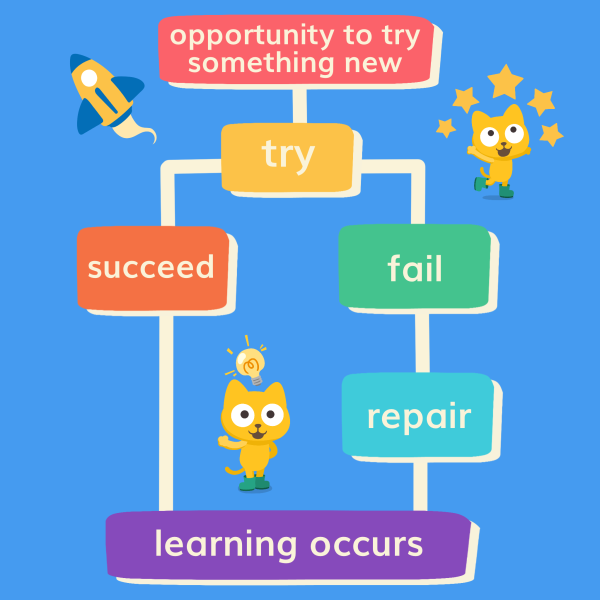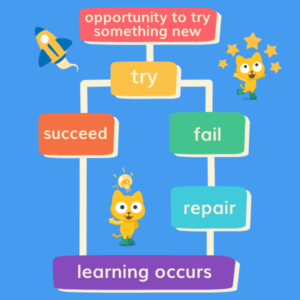“Mistakes are opportunities to learn.”
Whether you’ve seen it on a classroom wall, heard it from a teacher, or said it to your own students, the idea that mistakes are valuable learning tools has become a standard mantra in classrooms everywhere.
But how many of us actually live by this belief?
Let’s be honest: Nobody likes to make a mistake. Sure, we might learn from it at some point down the road, but in the moment of failure most of us don’t feel too good about ourselves. And that goes for our students, as well.
And as with any negative feeling, people have a knack for finding coping strategies to deal with their failures.
Typically, students will deal with their mistakes in one of the following ways:
1. Avoiding mistakes at all costs—even if it means copying answers or refusing to try in the first place.
- These students think, “Why should I try if I might not be able to do it?”
2. Withdrawing from their mistake and blaming it on someone or something else.
- In other words, “It’s not my fault that I messed up, so it doesn’t count as a failure.”
3. Minimizing their mistakes and looking past them as something unimportant.
- They might say, “I didn’t care about this, anyway.”
4. Regretting their mistake, and either:
getting caught in negative self-talk (“Why did I even bother trying? I’m not smart enough to do this.”), or…
engaging in self care and attempting to repair the mistake (“Whoops, that wasn’t right. I’ll try to find out where I went wrong and start again.”)
The result is something like this:

Each of these is an attempt to neutralize the negative feelings associated with failure—but only one of them leads to actual learning.
Which means that most students aren’t actually learning from their mistakes; they’re just trying to survive them.
The problem lies in the assumption that failure is a bad thing. Students avoid, withdraw, minimize, and regret their mistakes because they perceive mistakes as inherently negative.
If mistakes were perceived as neutral, students would not need these coping mechanisms to neutralize their emotions—instead, errors would just be considered part of the learning process (which, of course, is what we’ve been telling them all along).
In a classroom where mistakes and failure did not lead to negative feelings, students’ processing of their mistakes would look like this:

In a classroom like this, failure is not a roadblock; it’s a means of productivity. But eliminating the negative connotations of failure isn’t as easy as putting up an inspirational poster on the wall—and many teachers aren’t sure where to start.
How are teachers contributing to the problem?
Despite the fact that we already know the value of learning from mistakes, many teachers inadvertently contribute to our students’ negative associations with failure. And in an effort to help our students learn, we are actually making it more difficult for them to deal with their failures.
Here are some of the mistakes we’re making:
Public shaming:
Shaming students for their mistakes is a classroom management technique that still runs rampant in schools around the world—despite the fact that it can have extremely negative consequences on our students.
From color-coded behavioral charts to reading students’ grades aloud, teachers have come up with a lot of creative ways to “motivate” their students using shame. But when we display students’ mistakes for everyone to see in the hopes that their humiliation will somehow encourage them to do better, all we’re really doing is deteriorating our relationship with them and discouraging them from taking risks in the future.
Ignoring students’ mistakes:
Ignoring mistakes is another way teachers inadvertently contribute to the problem. One study showed how teachers in the United States are more likely to ignore students’ mistakes and focus on praising the right answers, compared to teachers in Japan who tend to focus on students’ errors in an effort to correct them.
While it’s not as intentionally harmful as public shaming, ignoring their mistakes still communicates to students that their failures are not worthy of discussing in class, and therefore have no place in learning.
Hiding our own mistakes:
As adults and authority figures, it can be tough for teachers to admit when we’ve made a mistake of our own. We want to be good role models for our students, which means doing everything perfectly at all times—right?
As it turns out, that’s not how modeling works. When we try to be “perfect” for the sake of our students, we’re showing them that perfect is the goal they should be striving for—when, as we all know, perfect is actually impossible to achieve. By hiding or covering up our own mistakes, we’re modeling feelings of shame and embarrassment, when we could be giving them the tools to learn from their mistakes by showing them how we learn from ours.
So what’s the solution?
We know that learning from mistakes can be a valuable practice for our students—and yet, most of us still treat mistakes as a bad thing. In order to really encourage students to learn from their mistakes, we need to intentionally normalize failure in the classroom. By eliminating the fear of making an error, we can create room for growth and genuine learning.
Here are 10 ways to change the way your classroom thinks about mistakes:
1. Build a positive classroom culture.
Many of the negative feelings associated with failure are external; shame and embarrassment have everything to do with how you perceive the people around you. In a classroom with a strong, positive sense of community, failure is no big deal—after all, there’s little reason to be embarrassed at making a small mistake if you’re in the company of friends.
2. Celebrate the learning that comes from mistakes.
The value of a mistake is what comes afterward. In the same way that you would celebrate any student’s success in your classroom, be sure to celebrate it even when it comes after a few failed attempts.
3. Foster a growth mindset.
Students with a fixed mindset can get caught up easily in mistakes and failures. By fostering a growth mindset in your classroom, you can help your students reframe the way they think about learning and growing from their mistakes.
4. Encourage grit and resilience.
Kids who are resilient have an easier time bouncing back from their mistakes and giving things another try. Spend time teaching your students to develop grit and persistence in order to keep them encouraged even through failure.
5. Have a sense of humor about failure.
Shame, guilt, and embarrassment are all feelings that can come from failure—and they’re all terribly heavy burdens to carry. By normalizing mistakes and taking a more lighthearted approach to talking about failure, you can show your students that it’s really no big deal.
6. Give every student plenty of opportunities to fail.
In many classrooms, it always seems to be the same group of students that experience failure most often. As a result, these students can start to feel weary of trying—while the other students don’t get any of the benefits of learning from mistakes. Be sure to challenge all of your students, and not just the ones who struggle to “keep up.”
7. Model how you deal with your mistakes.
When students see that even their teacher makes mistakes sometimes, they’ll know that it’s not a big deal—and they’ll learn from how you respond to failure.
8. Learn about their heroes’ failures.
Behind every big success story is a thousand small failures—and someone who didn’t give up on themselves. Help your students research the mistakes that their biggest heroes have made in the past, and learn how they worked through them to reach their goals.
9. Encourage risk-taking.
To make a mistake requires trying something new, and this often involves a healthy amount of risk-taking. While some teachers are hesitant to promote risk-taking in their classrooms, consider this: No one has ever accomplished anything great without taking a risk—and, personally, I’d rather have my students taking risks under my guidance and supervision than let them go unprepared into the world without any failures to have learned from.
10. Teach self-compassion.
Your students are undoubtedly going to experience failures beyond your classroom walls, and you won’t always be there to help them learn from it. By teaching your students to bounce back from their mistakes with patience, grace, and self-compassion, you are giving them the tools to lift themselves back up from any failure.
It’s true that mistakes are opportunities to learn—but only if we let them teach us something. In shifting the way we think about failure, both in the classroom and beyond, we can show our students just how valuable their mistakes can really be.


